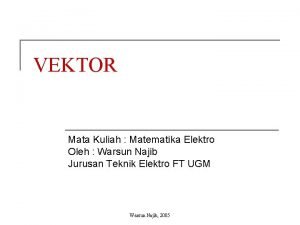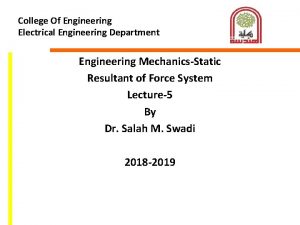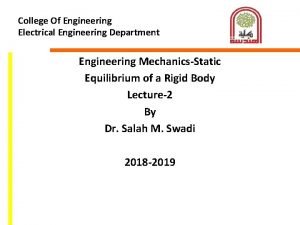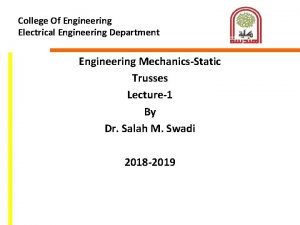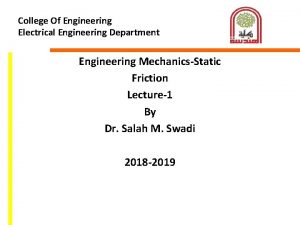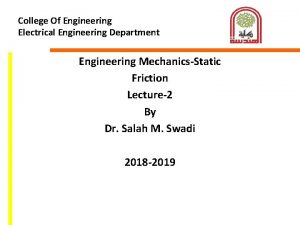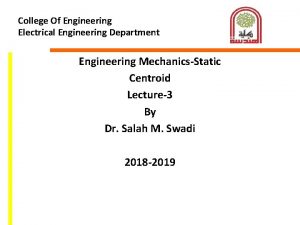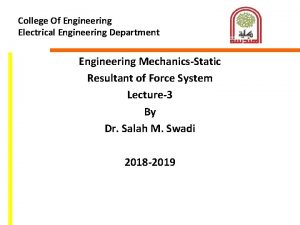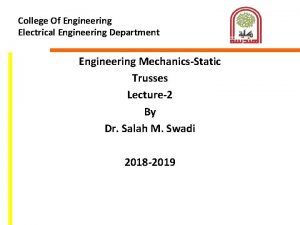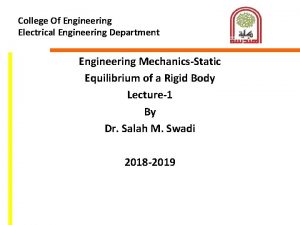College Of Engineering Electrical Engineering Department Engineering MechanicsStatic






![Solution Position vector r = [-2 m – 1 m]i + [2 m – Solution Position vector r = [-2 m – 1 m]i + [2 m –](https://slidetodoc.com/presentation_image_h/37753a36a58a015b49fc5d49d51579a0/image-7.jpg)






- Slides: 13

College Of Engineering Electrical Engineering Department Engineering Mechanics-Static Resultant of Force System Lecture-4 By Dr. Salah M. Swadi 2018 -2019

2. 7 Position Vectors • x, y, z Coordinates – Right-handed coordinate system – Positive z axis points upwards, measuring the height of an object or the altitude of a point – Points are measured relative to the origin, O.

2. 7 Position Vectors Position Vector – Position vector r is defined as a fixed vector which locates a point in space relative to another point. – E. g. r = xi + yj + zk

2. 7 Position Vectors Position Vector – Vector addition gives r. A + r = r. B – Solving r = r. B – r. A = (x. B – x. A)i + (y. B – y. A)j + (z. B –z. A)k or r = (x. B – x. A)i + (y. B – y. A)j + (z. B –z. A)k

2. 7 Position Vectors • • • Length and direction of cable AB can be found by measuring A and B using the x, y, z axes Position vector r can be established Magnitude r represent the length of cable Angles, α, β and γ represent the direction of the cable Unit vector, u = r/r

Example 2. 12 An elastic rubber band is attached to points A and B. Determine its length and its direction measured from A towards B.
![Solution Position vector r 2 m 1 mi 2 m Solution Position vector r = [-2 m – 1 m]i + [2 m –](https://slidetodoc.com/presentation_image_h/37753a36a58a015b49fc5d49d51579a0/image-7.jpg)
Solution Position vector r = [-2 m – 1 m]i + [2 m – 0]j + [3 m – (-3 m)]k = {-3 i + 2 j + 6 k}m Magnitude = length of the rubber band Unit vector in the director of r u = r /r = -3/7 i + 2/7 j + 6/7 k

Solution α = cos-1(-3/7) = 115° β = cos-1(2/7) = 73. 4° γ = cos-1(6/7) = 31. 0°

2. 8 Force Vector Directed along a Line • • • In 3 D problems, direction of F is specified by 2 points, through which its line of action lies F can be formulated as a Cartesian vector F = F u = F (r/r) Note that F has units of forces (N) unlike r, with units of length (m)

2. 8 Force Vector Directed along a Line • • • Force F acting along the chain can be presented as a Cartesian vector by - Establish x, y, z axes - Form a position vector r along length of chain Unit vector, u = r/r that defines the direction of both the chain and the force We get F = Fu

Example 2. 13 The man pulls on the cord with a force of 350 N. Represent this force acting on the support A, as a Cartesian vector and determine its direction.

Solution End points of the cord are A (0 m, 7. 5 m) and B (3 m, -2 m, 1. 5 m) r = (3 m – 0 m)i + (-2 m – 0 m)j + (1. 5 m – 7. 5 m)k = {3 i – 2 j – 6 k}m Magnitude = length of cord AB Unit vector, u = r /r = 3/7 i - 2/7 j - 6/7 k

Solution Force F has a magnitude of 350 N, direction specified by u. F = Fu = 350 N(3/7 i - 2/7 j - 6/7 k) = {150 i - 100 j - 300 k} N α = cos-1(3/7) = 64. 6° β = cos-1(-2/7) = 107° γ = cos-1(-6/7) = 149°
 Electrical engineering department
Electrical engineering department Tum
Tum Ucla ee department
Ucla ee department Pasadena city college police department
Pasadena city college police department Pengurangan vektor
Pengurangan vektor Gwu electrical engineering
Gwu electrical engineering Tel aviv university electrical engineering
Tel aviv university electrical engineering Northwestern computer science department
Northwestern computer science department Klipsch school of electrical and computer engineering
Klipsch school of electrical and computer engineering Umd ece faculty
Umd ece faculty Estimating and costing in electrical engineering
Estimating and costing in electrical engineering Electrical engineering environmental issues
Electrical engineering environmental issues Wpi ece tracking sheet
Wpi ece tracking sheet Electrical engineering presentation
Electrical engineering presentation




